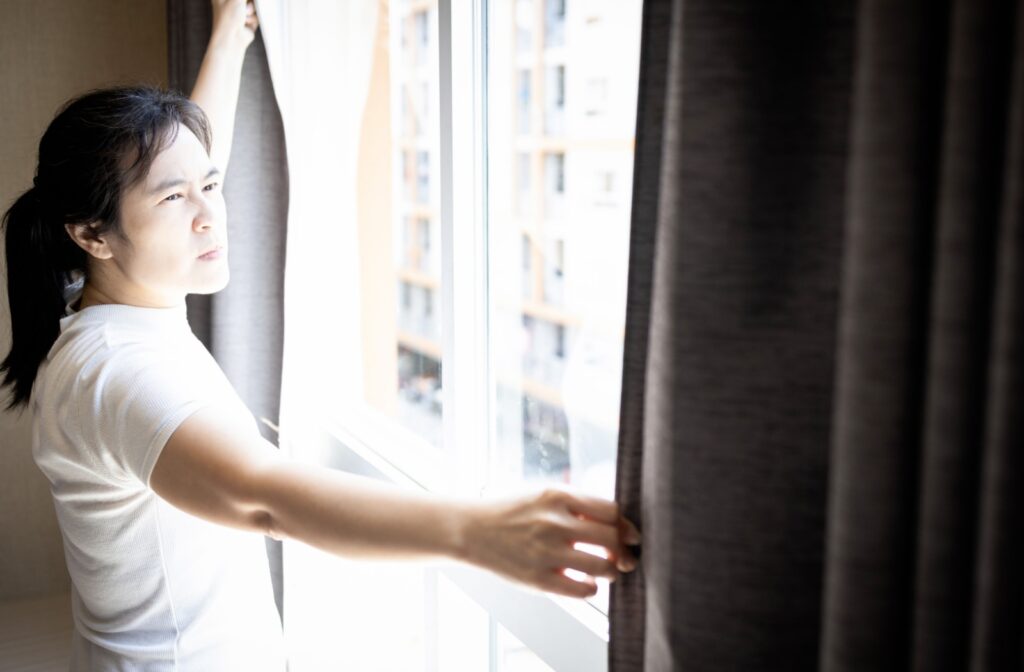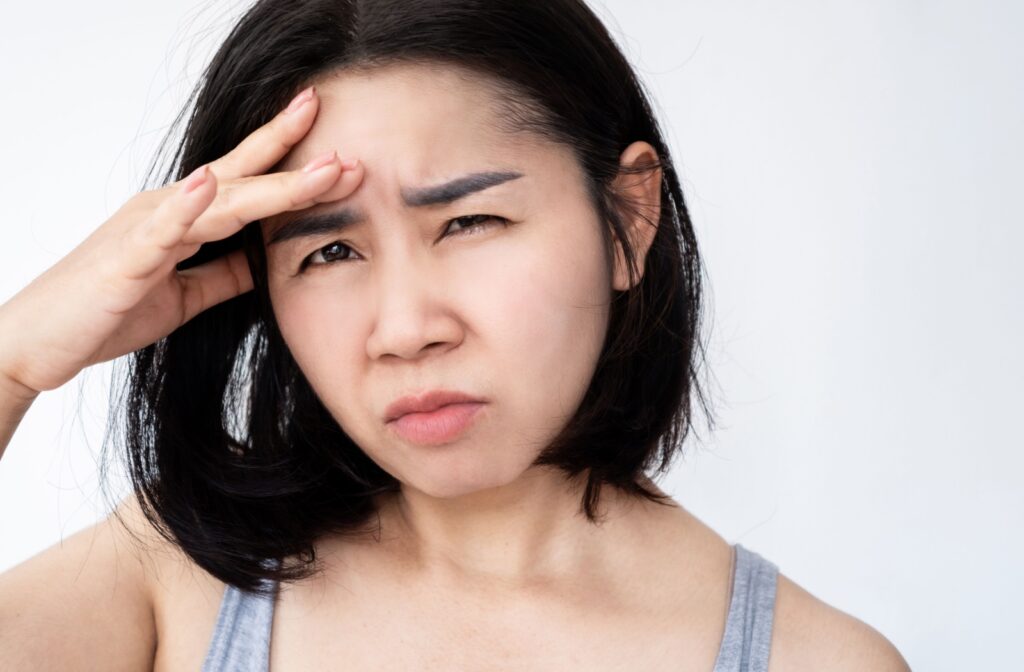If you’re struggling with dry, irritated eyes and notice that bright lights feel unbearable, you might wonder if these two issues are related. Indeed, dry eye and light sensitivity (also known as photophobia) often go hand in hand.
But if your symptoms get in the way of your everyday life, treatment options are available. Lifestyle changes, special eyeglasses, and treatments designed to improve tear function can help bring relief. Consider scheduling a comprehensive eye exam to get a personalized assessment of your unique eye health.
All About Dry Eye
Dry eye is a common condition in which tears don’t work properly to lubricate the eyes. Tears aren’t just for crying. They provide vital moisture, help prevent infection, and flush away debris. Not producing enough tears or having tears that drain too fast can lead to dry eye.
Certain factors place some people at higher risk of dry eye:
- Age and gender: Dry eye is more common among older people and women. Most people over age 65 have some symptoms of dry eye.
- Medications and health conditions: Some types of medications, including antihistamines and decongestants, can cause you to produce fewer tears. Meanwhile, underlying health problems like diabetes or thyroid conditions often have dry eye as a symptom.
- Eye procedures: Surgeries like LASIK and wearing contact lenses are linked to dry eye.
- Environment: Windy, smoky, and dry environments can trigger dry eye symptoms, as can extended screen time.
If you have dry eye, you may experience symptoms like:
- Grittiness, irritation, or scratchy and burning sensations
- Red eyes
- Watery eyes (this is your body trying to compensate)
- Mucus around your eyes
- Blurriness
- Increased sensitivity to light
Your tear film is made up of three layers: an oil layer, a water layer, and a mucin layer. If your oil layer is insufficient, your tears may evaporate more quickly, prompting your body to produce more watery tears. But these watery tears won’t hydrate your eyes properly without an adequate oil layer.
All About Light Sensitivity (Photophobia)
Light sensitivity, also known as photophobia, occurs when light causes discomfort or sometimes even pain. You may feel the urge to squint or blink a lot, or you may want to avoid bright places altogether, such as rooms with fluorescent lighting or bright sunny days.
There can be many causes for light sensitivity, such as:
- Eye conditions like dry eye, conjunctivitis, astigmatism, and crossed eyes (strabismus)
- Cataract and LASIK eye surgeries
- Neurological conditions like meningitis, migraines, and traumatic brain injury
- Certain medications
- Other conditions like allergies and chronic fatigue syndrome
The Connection Between Dry Eye & Light Sensitivity
Light sensitivity is a common symptom of dry eye. One study found that, besides migraines, dry eye was the most common cause of photophobia. Here’s why.
The eyes’ surface is protected by a tear film that consists of water, oil, and mucus layers. When this tear film is working correctly, light refracts properly onto your retina, leading to clear and comfortable vision. But in dry eye, the tear film’s stability has been disrupted. This causes light to scatter irregularly, causing light sensitivity. Dry eye can also cause inflammation and tiny erosions on the surface of your eyes.

Treatment Options for Dry Eye & Photophobia
If you’re experiencing dry eye and light sensitivity, talk to an optometrist. They can examine your eyes and find the underlying cause of your symptoms. Once the cause is better understood, you can discuss treatment options together.
Dry Eye Treatments
Dry eye can be deeply uncomfortable, but there are several ways to manage the condition:
- Lifestyle and environmental changes: Avoid triggering environments or wear wraparound glasses when you go outside. While indoors, consider placing a humidifier in your home.
- Home remedies: Consider resting your eyes more often (try the 20/20/20 rule) or placing a warm heat mask over your eyes for 10 minutes.
- Adding more tears: You can buy artificial tears over the counter without a prescription. These products may work for mild dry eye. Avoid eye drops with preservatives—these can be irritating. Prescription eye drops can also help you produce more tears.
- Keeping tears around longer: A procedure called punctal occlusion can block your punctum (where your tears drain), so tears stay on your eyes longer. These can be temporary or permanent.
- Treating inflammation: Eye drops, ointments, and eyelid cleaners may help reduce inflammation on your eyelid or eye surface.
Photophobia Treatments
There isn’t much research on how to treat photophobia due to dry eye, but there are ways to make yourself more comfortable. For example, many people find wearing tinted sunglasses helpful when they go outside. However, remember to take your sunglasses off when you return indoors. Keeping them on all the time can actually increase your light sensitivity. Try blue, green, purple, or yellow-tinted lenses.
Choosing natural and warmer light over fluorescent light may also help, as can adjusting the brightness settings on your devices. Regardless, it’s important to get a proper diagnosis of your light sensitivity symptoms from an eye doctor.
Dry Eye Therapy in Diamond Bar, CA
Dry eyes can seriously interfere with daily life activities. We can help you understand your condition and explore treatment options.
Total Vision Diamond Bar provides a wide variety of eye care services, including comprehensive eye exams for all ages, contact lens fittings, and eye disease management.To learn more, book an appointment with us today.



